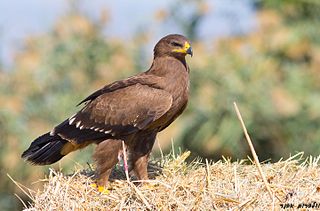
The lesser spotted eagle is a large Eastern European bird of prey. Like all typical eagles, it belongs to the family Accipitridae. The typical eagles are often united with the buteos, sea eagles, and other more heavy-set Accipitridae, but more recently it appears as if they are less distinct from the more slender accipitrine hawks than believed.

The Indian spotted eagle is a large bird of prey native to South Asia. Like all typical eagles, it belongs to the family Accipitridae. The typical eagles are often united with the buteos, sea eagles and other more heavyset Accipitridae, but more recently it appears as if they are less distinct from the more slender accipitrine hawks.
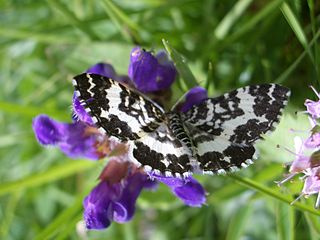
The argent and sable moth is a day-flying moth of the family Geometridae, with distinctive black and white colors. They tend to live on wetlands and hillsides. The larvae spin together the leaves of their food plants to form their cocoons. It was named argent and sable in 1778. Argent and sable refer to the heraldic color names for white and black. Their distribution is Holarctic. The species was first described by Carl Linnaeus in his 1758 10th edition of Systema Naturae.

Verbena hastata, the American vervain, blue vervain or swamp verbena, is a flowering plant in the vervain family Verbenaceae. It is a perennial herbaceous plant with opposite, simple leaves which have double-serrate margins, borne on stiffly erect, branching square stems. The purple flowers appear in summer. This is a common plant that occurs across North America. It is hardy and drought resistant.

Afzelechin is a flavan-3-ol, a type of flavonoid. It can be found in Bergenia ligulata. It exists as at least 2 major epimers.
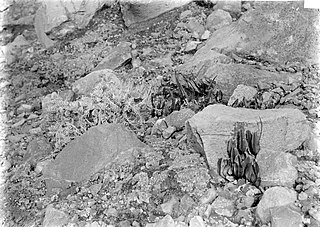
Selliguea feei is a fern belonging to the genus Selliguea in the family Polypodiaceae. This fern can be collected in Indonesia. The species name feei commemorates the botanist Antoine Laurent Apollinaire Fée.
Hastata, a Latin word meaning hastate or spear-shaped, may refer to :

Phacelia hastata is a species of flowering plant in the borage family, Boraginaceae. Its common names include silverleaf scorpionweed, silverleaf phacelia, and white-leaf phacelia. It is native to western North America from British Columbia and Alberta south to California and east to Nebraska. It can be found in many types of habitat, including scrub, woodland, and forest, up to an elevation of 13,000 feet. It prefers sandy to rocky soil.
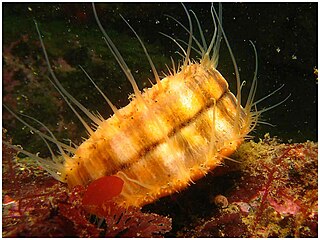
Chlamys hastata, the spear scallop, spiny scallop or swimming scallop, is a species of bivalve mollusc in the family Pectinidae found on the west coast of North America from the Gulf of Alaska to San Diego, California. A limited number of these scallops are harvested by divers or by narrow trawls off the west coast of Canada.
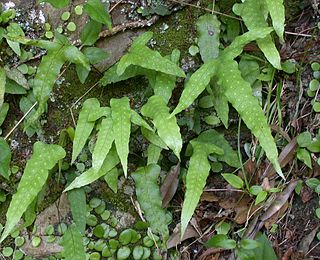
Selliguea is a fern genus in the family Polypodiaceae. The type species is Selliguea feei.

Chenopodium robertianum, known by the common name of saloop or berry saltbush is a small plant in the family Amaranthaceae. This species is found in coastal and inland areas of eastern Australia. Occasionally seen in rainforest gullies, though mostly seen in more open areas.

Salix hastata is a species of flowering plant in the willow family, known by the common name halberd willow. It has an almost circumpolar distribution, occurring throughout the northern latitudes of the Northern Hemisphere, most frequently found near the coast of the Arctic Ocean. In Alaska, it occurs in the north and in the central mountains. It also occurs in northwestern Canada, and in Norway and Russia, as well as various alpine or mountainous areas of Eurasia.
Drynarioideae is a subfamily of the fern family Polypodiaceae in the Pteridophyte Phylogeny Group classification of 2016 (PPG I). The subfamily is also treated as the tribe Drynarieae within a very broadly defined family Polypodiaceae sensu lato. In either case, it includes the previously separated tribe Selligueeae.

Kaempferol-3-O-rutinoside is a bitter-tasting flavonol glycoside. It can be isolated from the rhizomes of the fern Selliguea feei.

Pavonia hastata, commonly known as spearleaf swampmallow or pink pavonia, is a shrub in the family Malvaceae. The species is native to Brazil, Bolivia, Argentina, Paraguay and Uruguay. It was previously considered to be native to Australia as well, but is no longer thought to be.

Selliguea plantaginea is a fern species in the genus Selliguea.
Gymnogrammitis is a genus of ferns in the subfamily Drynarioideae of the family Polypodiaceae according to the Pteridophyte Phylogeny Group classification of 2016 (PPG I), with a single species Gymnogrammitis dareiformis.
Paraselliguea is a genus of ferns in the subfamily Drynarioideae of the family Polypodiaceae according to the Pteridophyte Phylogeny Group classification of 2016 (PPG I), with a single species Paraselliguea leucophora.














